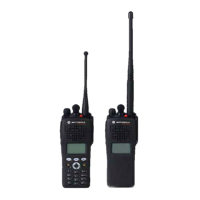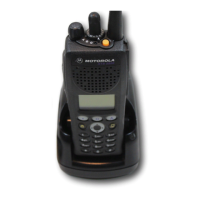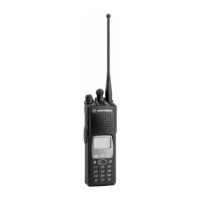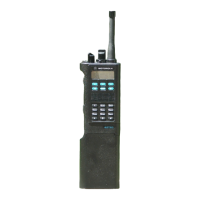Basic Theory of Operation
8
Transmitted signalling information is accepted by the DSP from the microcontrol
unit, coded appropriately, and passed to the D/A converter, which handles it the
same as a voice signal. Modulation information is passed to the synthesizer along
the modulation line. A modulated carrier is provided to the RF PA, which transmits
the signal under dynamic power control.
ASTRO Mode of
Operation
In the ASTRO mode (digital mode) of operation, the transmitted or received signal
is limited to a discrete set of deviation levels, instead of continuously varying. The
receiver handles an ASTRO-mode signal identically to an analog-mode signal up
to the point where the DSP decodes the received data. In the ASTRO receive
mode, the DSP uses a specifically defined algorithm to recover information.
In the ASTRO transmit mode, microphone audio is processed identically to an
analog mode with the exception of the algorithm the DSP uses to encode the
information. This algorithm will result in deviation levels that are limited to discrete
levels.
RF Basic
Theory of
Operation
The receiver front end consists of a preselector, an RF amplifier, a second
preselector, and a mixer. Both preselectors are varactor-tuned, two-pole filters,
controlled by the microcontroller unit through the D/A IC. The RF amplifier is a dual-
gate, gallium-arsenide-based IC. The mixer is a double-balanced, active mixer,
coupled by transformers. Injection is provided by the VCO through an injection
filter. See Table 2 for local oscillator (LO) and first IF information.
For the VHF band, the frequency generation function is performed by two ICs and
associated circuitry. The reference oscillator provides a frequency standard to the
Figure 3. RF Block Diagram for VHF (Power and Control Omitted)
Reference
Oscillator
FracN
U201
MOD
IN
Loop
Filter
LPF
FL200
EPIC
Y200
DAC
U203
VCO
VCO
Crystal
Filter
FL51
Mixer
U1
2ND
LO
Sample
Clk
To RX_SSI
From TX_SSI
Preselector
Filter
Attenuator
PCIC
U102
Power
Module
Q101
TX
Buffer
TX Driver
Amplifier
U101
RF Power
Detector
D103
Directional
Coupler
U106
Antenna
Switch
Preselector
Filter
RX LNA
Q29
To
Antenn
Harmonic
Filter
ABACUS III U401
MAEPF-27322-O
3
3
RX
Buffer
Table 2. Local Oscillator and First IF Frequencies
VHF
LO Frequency Range --
First IF Frequency 44.85 MHz

